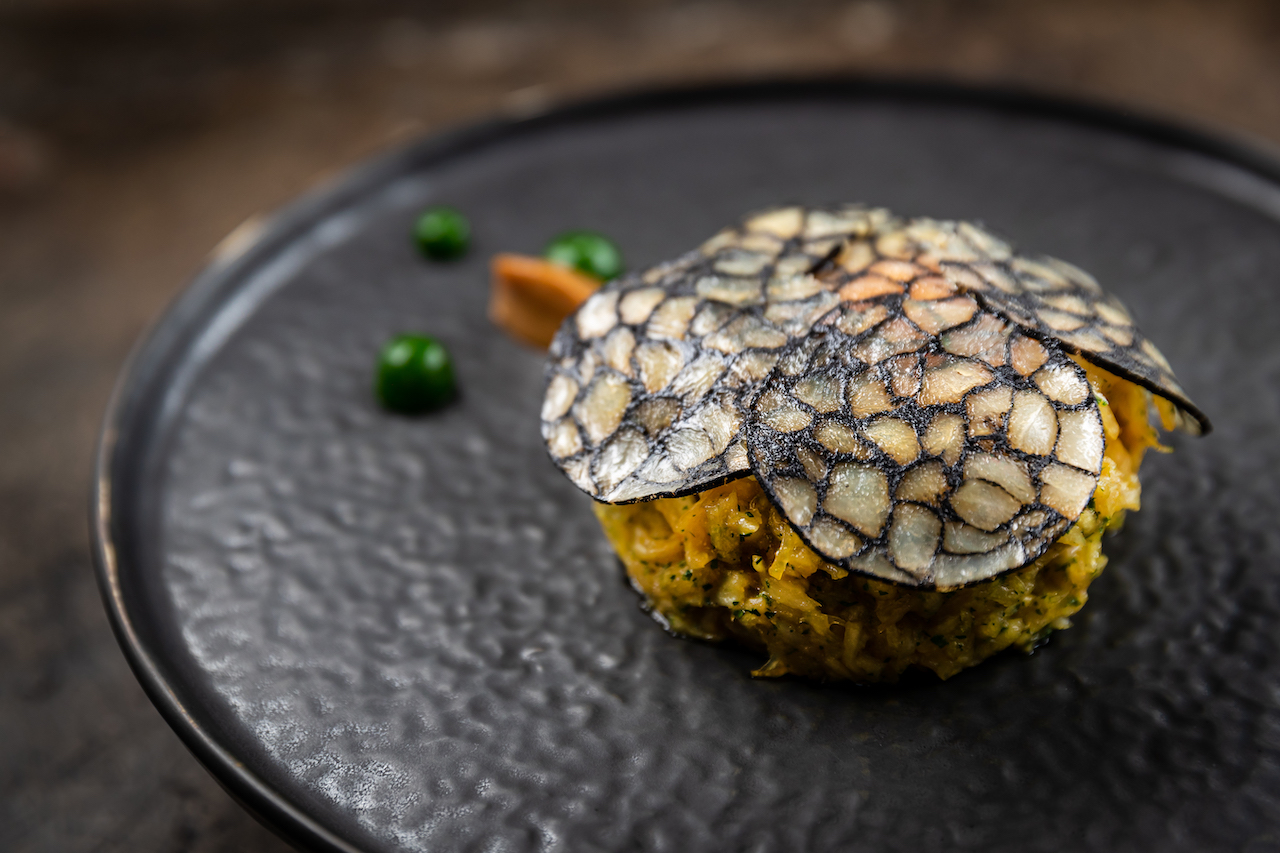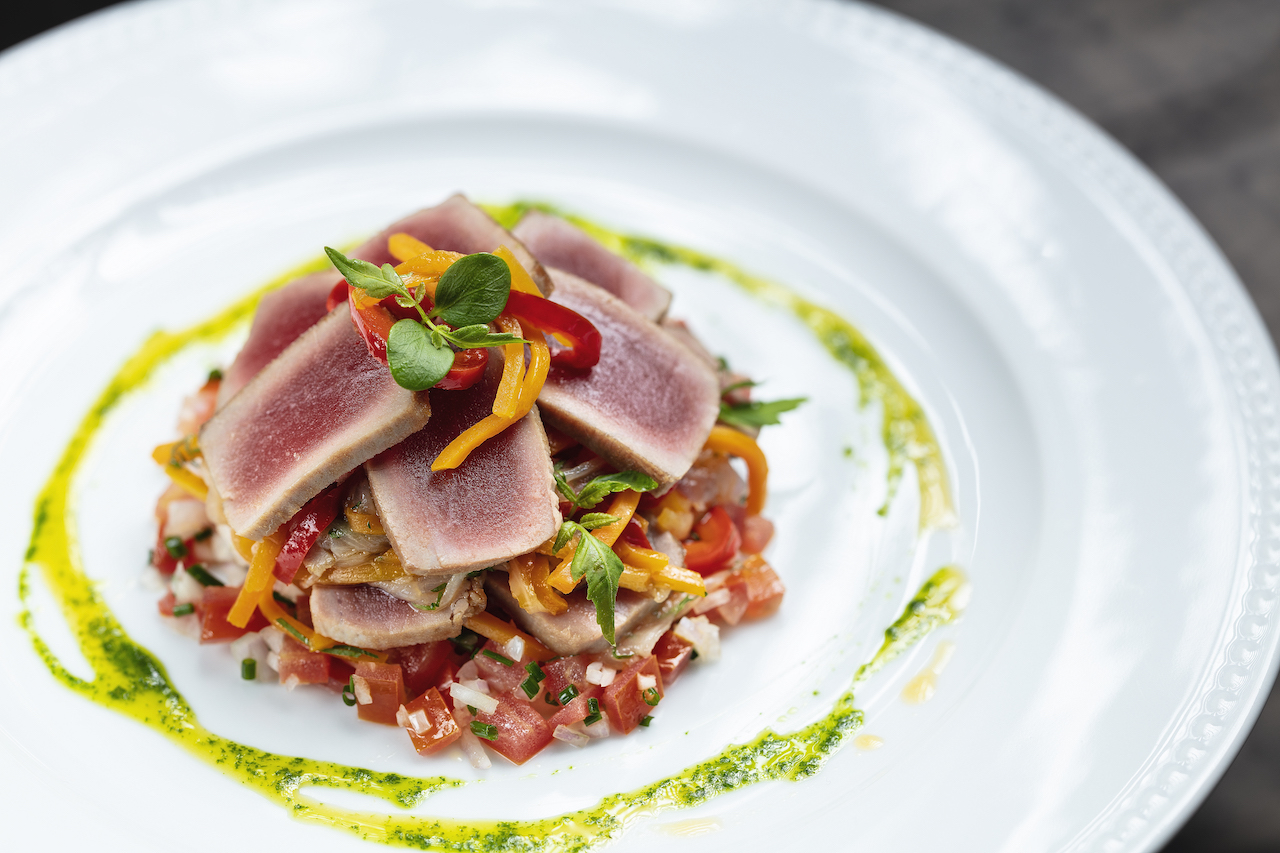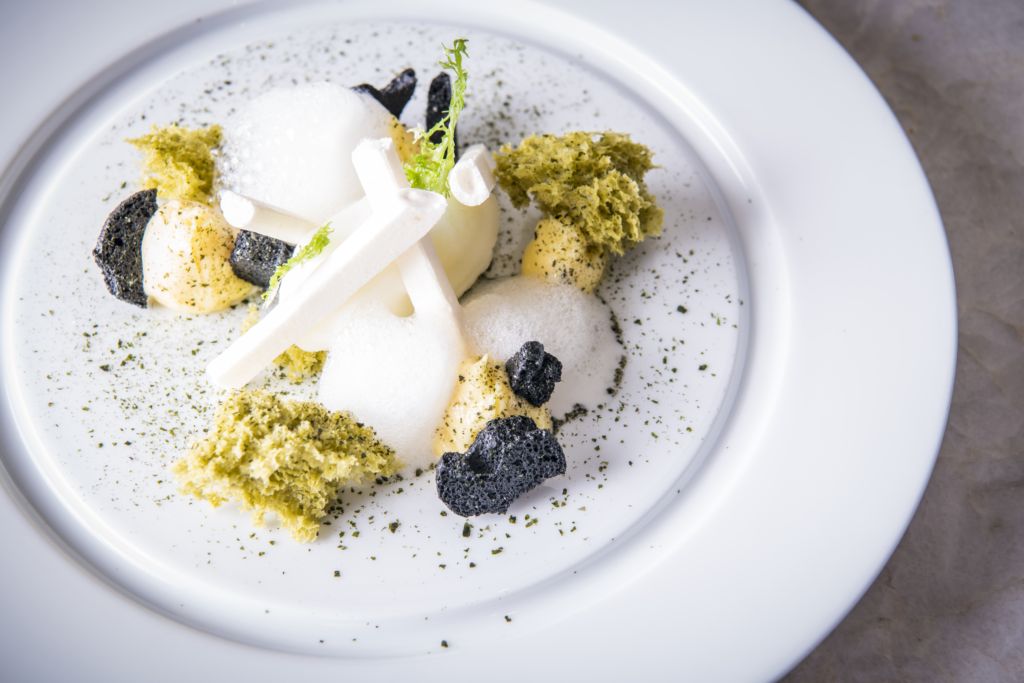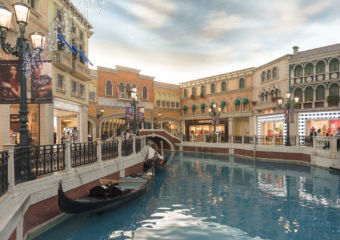With Michelin starred restaurants in Portugal, television shows about food, recipes, and family, Chef Henrique Sá Pessoa’s furthered his culinary business adventure by opening his first-ever restaurant outside Portugal. Located in Macau’s glittering Sands Cotai Central, Chiado offers contemporary Portuguese food that’s simple yet truly unique. Dishes here are expertly made by a team of Portuguese chefs along with local professionals. We sat down with Chef Henrique to find out more about how everything started, how he achieved two Michelin stars in three years, and his restaurant, Chiado!
You are a renowned Portuguese chef with more than 20 years in the business. How did everything start?
I don’t really have a special story about wanting to become a chef. I’m just a regular guy from Carcavelos and I was born asthmatic which brought me health issues with my respiratory system and a lack of appetite so I was usually forced to eat. This was the case until I was around 10 years old when I started playing basketball which was something I came to really love. My parents are divorced and this kind of situation is one that forces you to grow up. One of the things I had to learn was how to cook–simple things, of course–for when my parents were working late so food like lasagne and spaghetti bolognese.
During high school, I joined the AFS program, where youngsters exchange experiences and go live in the US and go to school there for the program’s given period. One of the classes we had there was something related to house chores like how to take care of the house, simple cooking and others. A cooking school recruiter came to one of the classes to recruit students for his school. He talked about how being a chef is cool, creative and allows a lot of travel. I was fascinated by his testimony so I asked my AFS coordinator if we could see the school. I did the admission exam, got a good grade and was able to get in. However, I didn’t have enough funds, so I returned to Portugal to earn some money then went back and joined the school.
What happened after you graduated?
I lived and worked–starting at Sheraton Grand London Park Lane–in London for three years, and then went to Sydney and stayed there for another three years. After that, my former wife and I went back to Portugal where things went really well although the idea was always to return to Australia. I lived there since 2002 and started in a hotel in Lapa (Lisbon) where I opened my first restaurant in Cascais, then moved on to the Bairro Alto Hotel. Afterward, I worked at Sheraton Lisboa Hotel & Spa. In 2009, my personal project, Alma, kicked-off. That’s when I also started doing television content. In 2015, Alma went from Santos to Chiado (Lisbon) and these past three years were more Michelin-star focused. To date, I have six establishments in Portugal and one outside Portugal, in Macau!
How did this partnership with Sands China come to life?
The first time I came to Macau was in 2012 and I was invited to host events at Clube Militar de Macau. At the time, I already knew some people in Macau. We started this relationship back in 2015 when they got in touch and said that there were plans for a Portuguese restaurant in one of their new properties. They asked if I was willing to join and at first, I was asked to do Macanese dishes but I decided that since Chiado is supposed to be a Portuguese restaurant, we must serve authentic Portuguese food

Salted cod À Brás with slow-cooked egg yolk, onion purée
What do you think is behind the success of Chiado?
I believe we as proud Portuguese people have to show that we are highly qualified professionals with a lot to show and give. This was why I was not flexible with the menu and insisted on my way of doing things. A partnership is like a marriage–when people get married, we don’t tell the other person they have to change. And that’s how I went about it. My ambition was to turn this restaurant into the best Portuguese restaurant in Macau in my own style. I feel like there aren’t many references when it comes to a restaurant like this especially within a property like Sands Cotai Central. That is why I wanted Chiado to become the very best!
Does the same concept apply to all your restaurants?
Each outlet has a different concept, but I see myself as an ambassador of modern Portuguese cuisine. Conceptually, if you ask me if I am a traditional Portuguese chef, I’d say no. However, I feel that the typical flavors are all here at Chiado–cataplana, codfish, and others. It’s not the same traditional Portuguese food as some people are used to and that’s why I say that this is not a traditional Portuguese restaurant but instead, we serve contemporary Portuguese cuisine. That being said, the way we cook and the condiments are truly Portuguese.
We’re becoming more and more refined. Initially, we planned to be a more casual restaurant, but as we see the space and feel the customers, the experience now, when compared to a year ago, it’s much more refined.
Why did you choose Macau to open your first overseas establishment?
I have a huge fascination with Asia, which started while I was living in Australia. When I first returned to Portugal, my menus had a strong Asian influence. 15 years ago, I was one of the first chefs to use lemongrass, chili, ginger and other exotic ingredients in dishes–it was kind of my signature move. Back then, Asian flavors were almost non-existent in Portugal but it’s become super trendy now.
I wanted to showcase Portugal gastronomy-wise especially because 90% of the people who come to my restaurants are foreigners. So why not show off the best of what we have?
Would you define it as fine dining then? What was the thought process behind this concept?
Yes, I think we can consider ourselves fine dining with close ties to traditional Portuguese food. Fine dining is usually characterized by the chef’s personal perspective. Here we have a more traditional approach to it, but up-to-date and polished. The main reason for this is that Macau already has a lot of traditional Portuguese restaurants. We thought that if we did the same, we would just be one more amongst the others, although there is always something new to offer. A more polished and refined dining experience–there isn’t anything like that. That’s the direction we’re aiming for from hereon.
When it comes to sourcing the best ingredients, how does it work at Chiado?
I don’t believe in bringing everything from Portugal because money-wise, it’s not worth it, and not ecologically sustainable. If I can find it here, I’ll use it, which is what we do with vegetables. There are no turnip greens in Macau, so I substitute it with “choi sam”. They’re similar and it might even please the Chinese customers more than turnip greens. I also need to have in mind that up to 90% of my customers are Chinese. There are of course some ingredients such as parma ham, chorizo, codfish, black pig and more that I can’t find here and have to import from Portugal. The fish we serve comes from the Mediterranean, and some of our seafood comes from Morocco. We have a new seafood dish on our menu now and we got barnacles from China. I’m trying to find exactly the same ingredients, but locally. This is something unusual for the local market as well, so it’s almost like trying to do Portuguese cuisine, but with local ingredients. It’s a challenge.
Do you make anything different at Chiado?
I had to scale down on the salt for savory dishes, and the sugar for sweets. Asians do favor sour and sweet dishes a lot but I found that conventional Portuguese desserts are too sweet for example. Bread, for example, was a complex challenge as well. We had several trials for Mafra bread which is a fresh, dense bread that’s really popular in Portugal. I was lucky enough to have a French baker from The Parisian Macao helping me out and we got it right!

Tuna tataki with vegetable escabeche and tomato tartare
What are Chiado’s signature dishes and the ones you like most?
Much like having children, you don’t have favorites and don’t like any better than the others. I love all the dishes and they are all different. The ones that have been with me the longest are the bacalhau à Brás (codfish with egg and fried potatoes), suckling pig and tataki tuna. In fact, tataki tuna was one of the dishes that resulted in me winning a contest back in 2005 in Portugal.
Would you describe your cuisine as “fusion”?
I was talking the other day about “fusion” and “confusion” cuisines. For the latter, one combines so many different ingredients and techniques that the dish itself gets lost along the way. One either does something really different from the norm and call it something new or make the dish traditionally but with your own flair. I believe that there is a degree of respect one must give to a recipe’s roots.
Which dishes would you recommend to someone who has never had Portuguese food?
I think the salted codfish à Brás is something you can’t really miss it, it’s the best way to be introduced to Portuguese food. I still think seafood rice remains a popular one as well. I think it’s something that really represents Portugal. When it comes to Asia, rice is something that almost means life, but what people don’t realize is that we (in Portugal) eat more rice than the Spanish. In fact, we’re the biggest consumer of rice in Europe. People don’t realize that because we’re not very famous for rice dishes, but when you go there, we have seafood rice, octopus rice, and others. 90% of our customers are Asian and they do love seafood rice and the suckling pork which have become popular in Chiado. It’s a no-brainer since there’s also a tradition of suckling pork around here.
What about for someone who’s familiar with Portuguese food, what would you say they should come to Chiado for?
For a Portuguese cuisine connoisseur, I think Chiado allows us to experience some dishes that are inspired by Portuguese cuisine but are still something new. The shellfish from the Portuguese coast in a citrus marinade with herb and seaweed salad, for example, you’ll recognize the bulhão pato, but then you’ll see it in a different way. If you choose to go for the seared scallops with green peas, chorizo sausage, and Hollandaise mustard, it’s also something familiar because people are used to eating green peas with chorizo, but not with scallops. From my understanding, scallops are something Portuguese people love to eat when they’re outside of Portugal, especially because we don’t have them there.
Can you tell us a bit about how things have been developing in Chiado since its opening?
At the end of the day, the customer’s the one who’s going to tell you if they like it or not. TripAdvisor is a great barometer: where we are the 19th restaurant in 950 restaurants in Macau–we’re already on their top 20 restaurants to eat in Macau! Although the direction we’re heading to is more towards fine dining, we still want to be an approachable restaurant.
Is that the way you’re heading?
I always believed that a restaurant should grow like a child. When Usain Bolt was born, people didn’t say he was going to be the 100-meter runner, right? I think he eventually grew up to be a runner and that the same applies to restaurants. Here, the strategy was more to open up and see where we grow. We realized, as we saw the type of people and customers coming in, that we could refine and polish it more and more to get where we are now. However, we still have the same prices as we did when we opened.
It’s been a year and I think we’re all about maintaining consistency and spreading the idea of the restaurant being Portuguese fine-dining based on a traditional matrix. Hopefully, people would come to Macau and think about Chiado as the place they’d go for something Portuguese, but with a more refined setting. Chiado should be the first one in people’s minds for that.
Do you believe only Portuguese people can cook authentic Portuguese food?
Not really. I believe one can teach anyone to cook anything. However, there is something one is unable to teach, at least during the starting phase: to understand your kitchen. Portuguese cooking requires that the feeling of a dish is passed along and you can have all the recipes, but if you don’t understand the flavors and ingredients, you won’t be able to deliver an authentic experience.
What makes Chiado stand out and what is its main draw?
I think the main difference is both the quality and the authenticity of the kitchen. When I say “authenticity” I don’t mean “traditional”. There are differences when it comes to the type of experience and opinion of Portuguese customers. For instance, a younger, more traveled one has a more positive approach, compared to someone older, who may be more traditional and has lived here for a long time usually says that they don’t expect dishes such as duck rice. Here, perspectives about Portuguese food are different. Menus in Portugal don’t usually have duck rice because that’s something you’d usually see in a lunch set or so.
Let’s talk about Michelin stars. How did that happen?
Chefs always dream of having Michelin stars, just like an actor wants to earn an Oscar. However, my professional path never had anything to do with it. I never worked with Michelin awarded chefs or in Michelin starred restaurants, but there was always a question in my head–can my food be Michelin star-worthy despite my journey? For several years, I felt that Portugal never really focused on Michelin stars and people didn’t even know what that meant. It was with this tourism boom that everything started to come together. I thought that if we started working for it, we might get it. Nine months passed and we actually did! We got our first star in 2016, and the second, in 2018.
What does it take to get there?
People forget that Alma is a project with a history of 10 years already. During its first five years, it was fine dining, but more like a bistro. We weren’t so focused on that target. When we opened Alma at the new place, there was already a lot of experience from before. There was some work to sharpen the recipes and that was it. The team is amazing, which helps a lot as well. We chose to employ young people fresh out of school so we could teach people who were willing to learn.
You also have a strong presence on TV. Where can people see you?
I think I might have been one of the first chefs from my generation to do TV shows. There was a big hiatus from popular TV shows during the 90s until I started. They were more traditional appearances and I feel “Entre Pratos” was kind of a breath of fresh air when it comes to this type of program. After that, I did some more shows. By the way, I also have a book in English called “Secret Ingredient” that’s available for purchase in Macau!
As a professional chef, you cook for a living so do you still cook at home?
Yes! Especially because I have a young daughter. Simpler dishes but of course I do cook. When you cook at home, you’re not thinking as a restaurant chef, but you still have a cook’s mindset. Sometimes we think people prefer more elaborate dishes but it’s not always the case. Passion is key in the kitchen and I believe that everyone can cook and food tastes much better when made with passion.

Ocean flavors and citrus, yuzu sorbet, crystallized algae
Chiado’s signature dishes and new menu favorites
Chiado is a place that, as the name indicates, makes recalling Lisbon very easy. Created by the hands of Portuguese chef Henrique Sá Pessoa, both the restaurant and its dishes take the experience of having Portuguese food to a higher level. With a different and fresh approach to the presentation, Chef Henrique knows that the devil is in the details: Both aesthetically and portion, as well as taste, all of these are meticulously considered until the plate arrives in front of you.
Must-try entrées include tuna tataki, seared foie gras and seared scallops with green peas, which is an interesting and different approach to a typical Portuguese dish made with poached eggs, green peas and chorizo. Classics such as cod à Brás or slow-cooked suckling pork are complemented with a series of visual details and tastes, delivering a different kind of experience to the palate. The first is decorated to look like the traditional cobblestones in Portuguese streets; the latter is served with sweet potato purée, presenting diners a sweet and sour experience.
New dishes include an Asian flair but still maintains very Portuguese aspects. Strongly influenced by the Asian cuisines, the duck breast with foie gras wonton, celeriac purée and spiced jus is a happy combination of savory meats with one of China’s most popular foods–wontons. And let’s be honest, who doesn’t like foie gras? Try this main course and we promise you won’t be disappointed. The shellfish from the Portuguese coast in a citrus marinade with herbs and seaweed salad is one of the chef’s new must-try dishes! Filled with oceanic flavors inspired by “bulhão pato” style clams, it’s a great way to start a gastronomic experience at Chiado. The seared scallops with green peas also bring strong Portuguese flavors to the table: this time, a fresh and new version of poached eggs, chorizo and green peas, a dish commonly served in Portugal as well.
The baked sea bass with salt is an ancient Portuguese dish that may not be as popular in recent times. At Chiado, Chef Henrique decided to bring it back to its kitchen and present it beautifully at the table. Visitors will be able to experience the fish being prepared at the table with the thick crust of salt removed from the fish, revealing the glistening flesh.
In 2020, Chef Henrique not only revamped the look of some of his bestselling dishes but also crafted interesting versions of known Portuguese ones, while creating entirely new dishes! Gather your friends and family for some hearty, beautifully presented and innovative Portuguese fare right in Macau, at Chiado.
For more information on Chiado, check their website here
Chiado Shop 2206, Level 2, Sands Cotai Central, Cotai, Macau, +853 8113 8988, www.sandscotaicentral.com/restaurants/western/chiado



































